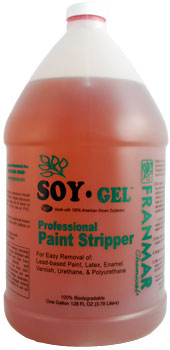What are Non Toxic Ways for Removing Paint from Furniture?

We recently received a question from a customer wondering how to safely remove paint from furniture. (If you’ve never used them before, traditional paint removers are incredibly toxic and the fumes are extremely noxious.) Being fans of fume-free renovation projects ourselves, of course, we have a couple of toxic-free tips up our sleeves. Today we’re sharing two non-toxic ways for removing paint from furniture.
1. Removing Furniture Paint with a Heat Gun.
We discovered this non-toxic method from Gina Luker. Gina is a DIY addict and runs this incredible blog called, The Shabby Creek Cottage. Be sure to check it out for some insightful home decor DIY ideas!
How it works: Start by getting your hands on a durable heat gun like the Home Right Heat Pro Deluxe 2 Heat Gun. Plug in the heat gun and begin going over small sections of the painted furniture (Gina suggests working in small 4 inch square areas). Handle the heat gun with extreme caution as the air can reach a scorching 1000 degrees. The heat will cause the paint to loosen and eventually bubble (check out image below). Once bubbling, take a scraper and start removing the paint off the surface. Depending on the number of original coats, it may take a couple rounds of reheating and scraping to reach the original wood surface. Once you have all the paint removed, sand the area and you’re free to refinish!

2. Removing Furniture Paint with Franmar SoyGel.
How it works: First, get your hands on FranMar SoyGel, Paint and Urethane Remover. Franmar SoyGel packs three times the punch of traditional strippers while being totally non-toxic and eco-friendly. Simply spread the solution across the surface and wait 30 to 60 minutes. After waiting, the paint will be soft enough for you to scrape off. Then, simply follow with a cleaner or degreaser before beginning the repainting process. It’s as simple as that!

[IMPORTANT] Before you start stripping, make sure to test whether your old furniture paint contains lead. If your piece of furniture was painted before 1978, there’s a good chance that the paint contained lead. As lead paint ages it can degrade into dust which can cause serious health problems. Get a U.S. Environmental Protection Agency recognized test kit if you know how old your furniture is or if you are just not sure. It’s better to be safe than sorry. If traces of lead are found, it’s typically safest to simply paint over it instead of disrupting the lead paint.
Now that you know how to safely remove furniture paint and the importance of watching out for lead, let the refinishing begin! And, while you're at it, why not use one of our non-toxic paints*! We have a huge selection of paints and stains and varnishes for furniture, cabinets, trims, and so much more!
Got any other questions you’d like us to answer? Comment with them below and we’ll do our best to answer them!
*Conforms to ASTMD-4236, specifically concerning oral toxicity, skin irritation and respiratory effects.

























